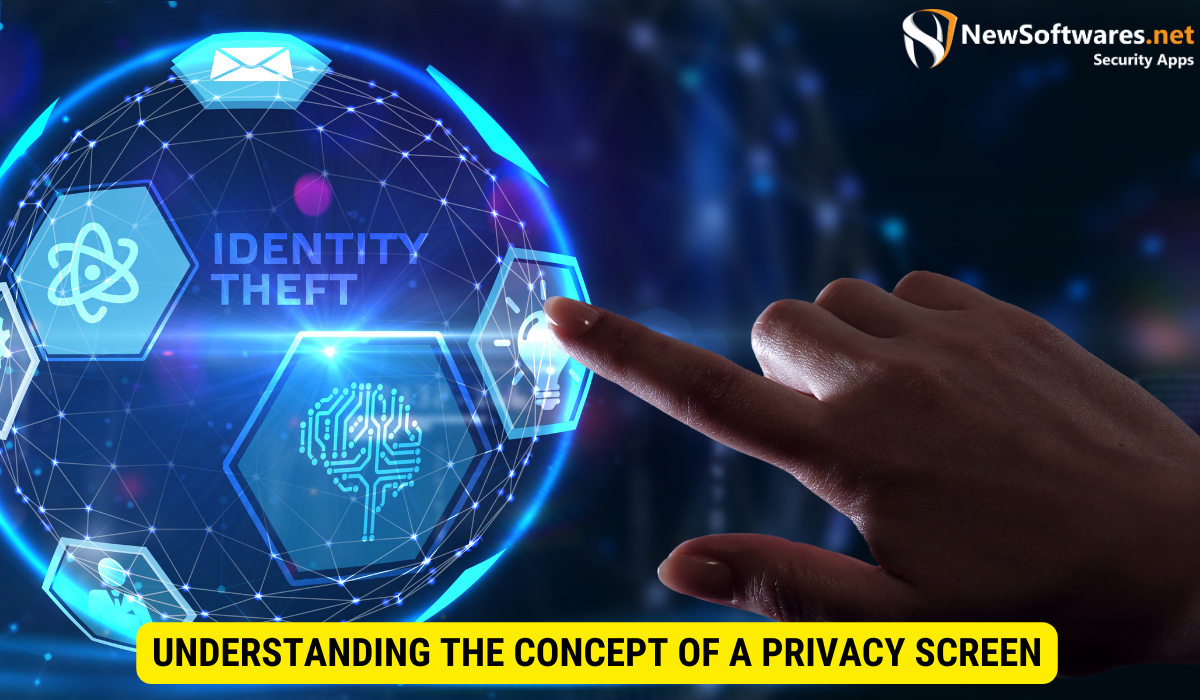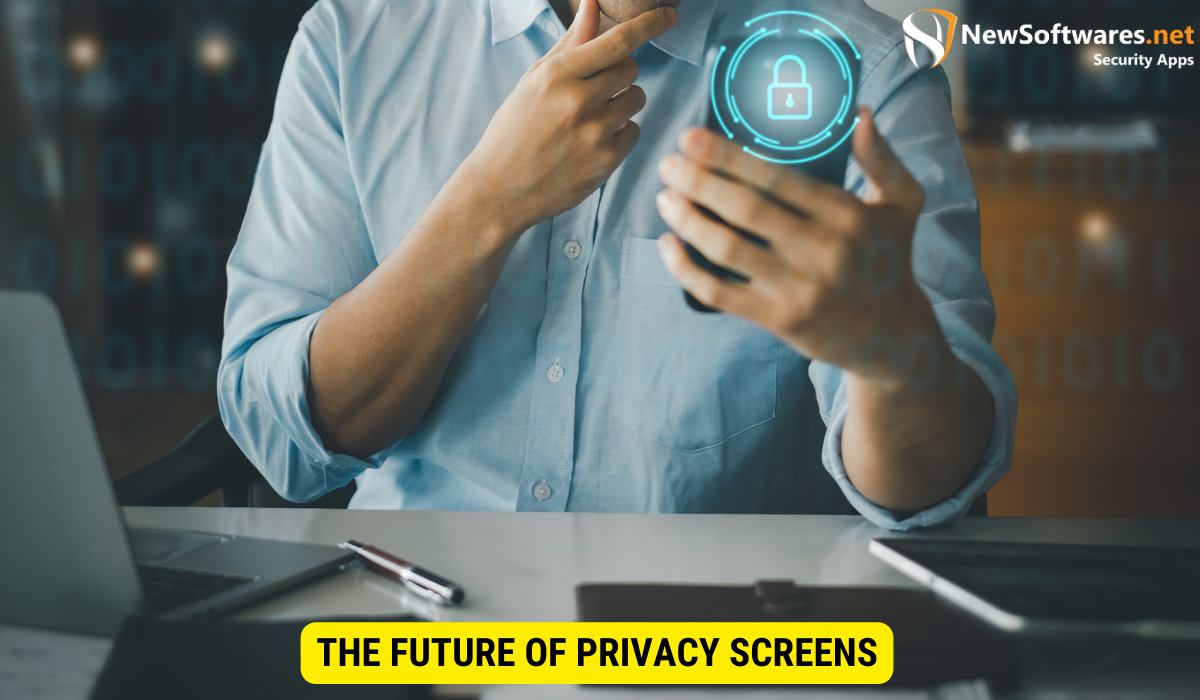A privacy screen is a device that shields sensitive information displayed on electronic devices from unauthorized viewing. It limits the screen’s viewing angle using micro-louvers or polarization layers, making it visible only to the user in front. Privacy screens are crucial for data security, preventing prying eyes from accessing confidential information.
A privacy screen is a device that helps protect the confidentiality of sensitive information displayed on electronic devices, for instance laptops, smartphones, and tablets. It is designed to limit the screen’s viewing angle, making it difficult for people sitting or standing nearby to see the content. I will explore the idea of privacy screens, how they work, their role in data security, tips for choosing the right one, and their future advancements.
Understanding the Concept of a Privacy Screen

A privacy screen, also known as a privacy filter or a laptop screen protector, is a physical or software-based layer that prevents visual information from being easily visible to unauthorized individuals. It is commonly made of micro-louvers or polarization layers that limit the screen’s viewing angle and reduce glare.
Privacy screens are designed to provide an additional layer of security for individuals who work with sensitive information. In today’s digital age, where data breaches and identity theft are prevalent, protecting confidential data has become more critical than ever.
When using a privacy screen, the display appears dark and distorted to anyone not directly in front of it. This feature confirms that only the person sitting straight in front of the screen can see the content. It effectively blocks the view from side angles, preventing prying eyes from reading confidential information.
The Importance of Privacy Screens
Privacy screens play a crucial role in protecting sensitive data from prying eyes. Whether working in a cafe, on a plane, or in a public space, preventing unauthorized individuals from reading confidential information displayed on your screen is essential. Data breaches can lead to harsh consequences, including financial loss, identity theft, or corporate espionage.
Imagine working on an important project containing sensitive client information in a busy coffee shop. Without a privacy screen, anyone nearby could easily glance at your screen and potentially gain access to confidential data. This scenario highlights the importance of privacy screens in maintaining the privacy and security of sensitive information.
Privacy screens are not limited to laptops; they are also available for desktop monitors, tablets, and smartphones. These screens are particularly useful for individuals who work in public spaces or travel frequently. By using a privacy screen, you can have peace of mind knowing that your confidential information remains protected, even in crowded environments.
Furthermore, privacy screens also help reduce glare, making it cooler to work in brightly lit environments. The micro-louvers or polarization layers in the screen filter out the excess light, allowing you to focus on your work without straining your eyes. This feature is especially helpful for individuals who spend long hours in front of their screens.
In addition to their practical benefits, privacy screens also offer a sense of privacy and confidentiality. They create a physical barrier between you and those around you, ensuring your work remains private. This can be particularly important in open office environments, where colleagues or visitors may inadvertently catch a glimpse of your screen.
In conclusion, privacy screens are essential for safeguarding sensitive information and maintaining privacy in today’s digital world. Whether you’re a business professional, a student, or someone who values your privacy, investing in a privacy screen is a wise decision that can help protect your confidential data and ensure peace of mind.
How a Privacy Screen Works
A privacy screen is a device that helps protect sensitive information displayed on electronic devices from being viewed by unauthorized individuals. It works based on the principles of light polarization and angular limitation, providing users with an added layer of security.
The Science Behind Privacy Screens
Privacy screens utilize micro-louvers or polarization layers built into the display filter. These layers are designed to control the direction of light, allowing only specific angles to view the screen. When viewing the screen from the front, the pixels align, and the information is displayed correctly. However, from any other angle, the light passing through the screen is blocked or scattered, making it difficult for others to see the content.
This technology is based on light polarization, which refers to aligning light waves in a specific direction. The privacy screen’s micro-louvers or polarization layers are precisely engineered to allow light waves aligned in a certain direction to pass through while blocking or scattering light waves aligned in other directions.
By controlling the direction of light, privacy screens ensure that only the intended viewer can see the content on the screen while preventing others from obtaining sensitive information.
Different Types of Privacy Screens
Privacy screens come in various forms, each offering different levels of convenience and functionality. These include removable filters, adhesive films, and integrated screen protectors.
Removable privacy filters are commonly used in office settings and are easy to install and remove. They are suitable for individuals who occasionally require privacy, as they can be easily attached to the screen and taken off when privacy is no longer needed. These filters are often made of high-quality materials that block side views, ensuring that only the person directly in front of the screen can see the content.
Adhesive films, on the other hand, provide a more permanent solution for privacy. These films are applied directly to the screen and offer higher screen protection. They are designed to adhere securely to the display, providing a seamless appearance while limiting viewing angles. Adhesive films are popular among individuals who prioritize long-term privacy and screen protection.
Integrated screen protectors are pre-installed on devices and provide built-in privacy functionality. These privacy screens are designed for devices like laptops, smartphones, and tablets. They offer a convenient and integrated solution, ensuring privacy without additional accessories. Integrated screen protectors are often made with high-quality materials that protect the screen from scratches and smudges and restrict viewing angles, making it difficult for others to see the content.
Overall, privacy screens are essential for individuals and organizations handling sensitive information. By harnessing the principles of light polarization and angular limitation, these screens effectively safeguard privacy and prevent unauthorized access to confidential data.
The Role of Privacy Screens in Data Security
Protecting Visual Data with Privacy Screens
Privacy screens serve as an additional layer of protection for visual data. They help prevent shoulder surfing, where individuals attempt to gain unauthorized access by observing screens from a distance. By limiting the viewing angle, privacy screens ensure that only the user sitting directly in front of the display can see the content.
Privacy Screens and Cybersecurity
While privacy screens provide visual protection, it’s crucial to remember that they are not a foolproof solution for complete data security. Privacy screens primarily prevent visual eavesdropping, but they do not protect against other cybersecurity threats, such as malware, hacking, or data interception during transmission. Therefore, it is important to implement a comprehensive security strategy that includes privacy screens as one component among many.
Choosing the Right Privacy Screen
Factors to Consider When Buying a Privacy Screen
When selecting a privacy screen, there are several factors to consider. Firstly, determine the compatibility with your device, ensuring that the screen size and model fit correctly. Additionally, consider the viewing angle range and polarization technology to balance privacy and usability. Other factors to consider include anti-glare properties, ease of installation, and durability.
Maintenance and Care for Privacy Screens
Regular maintenance and care are essential to prolong your privacy screen’s life. Routine a soft microfiber cloth to clean the screen, and avoid using harsh chemicals that may damage the filter. Be cautious when applying pressure to the screen or using sharp objects, as this can result in scratches or impair its functionality. Additionally, protect the screen when unused and store it safely to avoid accidental damage.
The Future of Privacy Screens

Technological Advancements in Privacy Screens
As technology continues to evolve, privacy screens are also advancing to meet the changing needs of users. Manufacturers are exploring new materials and techniques to improve the clarity of displays while maintaining privacy. Some privacy screens now offer the ability to switch between private and public viewing modes, enhancing user convenience. Furthermore, the future may bring innovative solutions such as biometric authentication integrated into privacy screens for enhanced security.
The Impact of Privacy Screens on Modern Data Security
Privacy screens have become an integral part of modern data security strategies. By safeguarding visual data from unauthorized viewing, they contribute to maintaining privacy, confidentiality, and compliance with regulations, for example, the Regulation (GDPR) General Data Protection and the Health Insurance Portability and Accountability Act (HIPAA). Privacy screens not only protect sensitive information but also instill a sense of trust and confidence among individuals who handle or access confidential data.
Key Takeaways
- Privacy screens protect visual data by limiting the viewing angles and making it difficult for unauthorized individuals to see the content.
- They work based on principles of light polarization and angular limitation.
- Privacy screens are not a comprehensive solution for data security and should be used in conjunction with other cybersecurity measures.
- When choosing a privacy screen, factors include compatibility, viewing angle range, polarization technology, anti-glare properties, installation ease, and durability.
- Regular maintenance and care are necessary to prolong the lifespan of privacy screens.
- The future of privacy screens may involve technological advancements and the integration of biometric authentication for enhanced security.
- Privacy screens play a significant role in modern data security, preserving confidentiality and compliance with regulations.
FAQs
Do privacy screens affect the quality of the display?
Privacy screens may slightly affect the visibility and brightness of the display as they limit the viewing angles. However, technological advancements have improved clarity and reduced the impact on display quality.
Can privacy screens protect against hacking or data interception?
No, privacy screens primarily prevent visual eavesdropping and do not directly protect against hacking or data interception. They are just one comprehensive data security strategy component that should include other cybersecurity measures.
Are privacy screens only necessary for sensitive data?
While privacy screens are particularly useful for protecting sensitive data, they can also benefit anyone concerned about their privacy, regardless of the information displayed. Privacy is a fundamental right that should be respected personally and professionally.
Conclusion
Privacy screens are indispensable tools for safeguarding sensitive data in today’s digital age. They operate by limiting viewing angles and protecting against visual eavesdropping, enhancing data security. While they should be part of a broader data security strategy, privacy screens play a crucial role in maintaining privacy, confidentiality, and regulatory compliance. As technology evolves, these screens continue to advance, offering improved clarity and potential innovations like biometric authentication for enhanced security.
